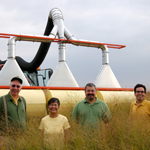New Technology Improves Native Grass Seed Harvest
Media Contact:
Jennifer Martin, (202) 720-8188
By Stacy Kish, CSREES Staff
August 27, 2008

Seedster PCS-Vac
Credit:
Bruce Morrison
Native grasses are reaching new heights of importance through potential use in the biofuels industry and in restoration of reclaimed or disturbed lands.
Producers in the native seed industry have responded to increased commercial demand, but current harvesting techniques for many grass species have not been up to the task. With funding from the USDA Small Business Innovation Research (SBIR) program, a project team in Montana has developed new equipment to efficiently harvest more types of seed.
The structure of native grass seed makes harvesting with current equipment complicated. Specifically, this equipment is unable to effectively dislodge, separate, convey and offload grass seed, resulting in low harvests, limited supplies and high prices.
Lee Arbuckle and colleagues at Arbuckle Ranch, Inc., received a series of SBIR Phase I and Phase II funding to develop technologies in a break-though grass seed harvester, the Arbuckle Native Seedster.
Arbuckle used the SBIR funding to develop and patent counter-rotating combs and brushes to effectively dislodge, or "pluck," the seed from difficult-to-harvest grass species. This cost-effective technology is easy to manufacture and maintain. The Seedster collects a high percentage of standing seed with minimal impurities, which eliminates the need for in-field separation of seed and chaff. The Seedster effectively harvests at higher ground speed for more productivity.
The second SBIR-funded project dealt with transporting seed without plugging the Seedster's internal system. Arbuckle's group developed two systems to achieve this goal. First, the Pneumatic Conveyance System (PCS) uses a vacuum fan and cyclone separator to suck plucked seeds through tubing for collection in a standard seed tote bag situated on a trailer.
The second system uses the integrated dislodgement, conveyance and collection hopper in a single loader mounted unit on a tractor. A simple mechanism supplements the air flow produced by the brush and combs to thrust dislodged seed into a collection hopper. A load of up to 1,500 pounds of seed easily dumps into a truck or trailer. This design was developed in late 2007 and is particularly appropriate for tall grass species, such as switchgrass.
The PCS model was released commercially in late 2007. One customer stated, "I believe your machine is probably the best harvester available for native seed that I've found."
In January 2008, Native Seedster entered a contractual agreement with Ceres Inc., an energy company, to design and produce a seed harvester to harvest upland and lowland switchgrass. Ceres will manufacture switchgrass, high-biomass sorghum and other crops from thousands of acres near St. Joseph, Mo., to support a next-generation bio-refinery engineered by ICM, Inc., a leading biofuel process technology provider.
Dr. Ken Vogel of USDA's Agricultural Research Service also reported in January 2008 the results of a three-state, five-year study showing that switchgrass ethanol produces 540 percent as much energy as it consumes and reduces greenhouse gasses by 94 percent compared with petroleum.
CSREES funded this research project through the SBIR program. Through federal funding and leadership for research, education and extension programs, CSREES focuses on investing in science and solving critical issues impacting people's daily lives and the nation's future. For more information, visit www.csrees.usda.gov.
Visit www.nativeseedsters.com for more information on the Arbuckle Native Seedster.
###
Last Updated: 08/27/2008





